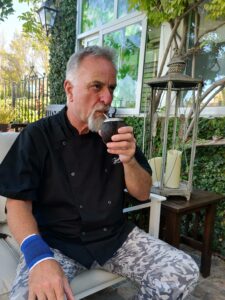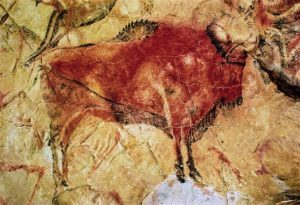The Auroch or Urus (Bos Taurus Primigenius) is the direct ancestor of all cattle; it had a similar ancestor called Bos Acutrifons that is thought to have roamed Central Asia some two million years ago. From there Aurochs spread all over Asia, Europe and the north of Africa. Remains have been found in the Iberian Peninsula dating from some 800 thousand years. It slowly disappeared due to hunting and domestication, however it left us with three sub-species.
- The Auroch or Urus (extinct)
- The Zebu (humped and domesticated on the Indian sub-continent)
- Domestic cattle (first domesticated in Greece and the Maghreb)
All the different breeds of cattle we know today descend from this last subspecies and despite the fact that biologists claim that this isn’t so, because they have been domesticated, we will continue to sustain that all of them have the genes of the ancient Auroch or Urus.
The fact of the matter is that this breed of cattle domesticated in North Africa reappeared in the Iberian Peninsula across the Straits of Gibraltar around 1000 BC. They have been around for over two thousand years and have produced a variety of Andalucian breeds, which are the result of cross breeding, diet and the “neighbourhood” where they lived.
One hot day in the year 1493 a certain Christopher took some of these cows on a cruise across the Atlantic in his caravel to an island he had named “La Española” (Santo Domingo). In order not to overload his vessel he took calves of the Berrenda, Negra Andaluza and Pajuna breeds.
These and their descendants were not allowed to leave the island as they were difficult to breed and the authorities preferred to keep them under control. In 1524 a cattle rancher who had invested a great deal of money in breeding cattle was allowed to take 200 head from La Española to the mainland, specifically to the port of Santa Marta (Colombia). This businessman was called Rodrigo de Bastidas and at the time he had 10000 head of cattle on the island.
In Argentina the first “criolla” cows, as they were called throughout the Americas, entered via Tucuman from Potosí brought by Juan Nuñez de Prado in 1548. Three years later Francisco de Aguirre crossed the Andes with cattle from Chile. However it is thought that the cattle that most influenced the development of cattle breeding in the southern part of the continent were the seven cows and the bull brought by the Goes brothers from Paraguay in 1556.
The founder of the cities of Santa Fe and Buenos Aires, Juan de Garay, brought five hundred head from Asunción in Paraguay and freed them in several provinces in the centre of the country. From then on and thanks to the excellent pasture in the pampas the cattle bred rapidly. There are censuses from areas close to Buenos Aires that state that in 1650 five ranches had 12000 head of cattle between them. It is calculated that by the year 1700 there were already some 40 million head of cattle in the region.
Despite this super population of cows, the human population did not in general use them for food. Before cattle appeared the people got their meat from the ostrich, the small indigenous boar, duck, quail and partridges. Little by little the population began to eat beef and horsemeat but this was by no means universal.
At the beginning of the 17th century both wild and domestic cattle were killed for their hides and tongues, the rest of the carcase was left to rot or thrown away. Indians and gauchos, expert horsemen and wielders of knives and “boleadoras” (Ref 18) carried out these dangerous tasks
The export of leather, mainly to Britain, generated huge profits for the local trade and many POUNDS for the British economy since much returned to the Americas in the form of boots, shoes and saddles.
After 1760 the first Industrial Revolution was getting under way and new markets were fundamental for the manufactured products and as sources of raw materials. There was a growing commercial exchange and many companies of British origin established themselves in this part of America.
After 1788 the first salteries were set up on the shores of the River Plate and from then on the whole animal began to be used, these were slaughtered on the ranches themselves or in the salteries. The procedure was to skin the animal, as the hide was the most valuable part, then the fat, which was the raw material for the manufacture of candles and soap, was removed and last the meat, was cut into strips and piled in layers with salt in between.
After ten days the meat was exposed to the sun and then piled in layers again with more salt. After 40 days the meat was ready to be consumed. Most of this meat called Charqui or Jerked beef (jerky) was sent to Brazil, the West Indies and the United States as food for slaves.
The best cuts of this salted and/or smoked beef (jerky) was sent to Europe but the meat of the local creole breed was not to the taste of either the European or British palate. So the ranchers set too and introduced other breeds of cattle into our fertile lands to improve the local creole breed. This is how new breeds from Britain were introduced: the Shorthorn in 1826, Hereford in 1858/60 and Aberdeen Angus in 1879 (Ref.22)
Around 1870 the salteries gradually are transformed into meat processing plants. This did away with the export of cattle on the hoof or jerky and the export of processed and frozen meat began. This great new market meant that the ranchers had to improve their pastures and give over more land to this lucrative business.
The first processing plant in Latin America was the River Plate Fresh Meat, which was set up in Campana (province of Buenos Aires), and the first shipment of refrigerated meat was sent to London in 1883. The Argentine meat processing industry in 1897 was totally owned by British capital. It could be affirmed that the POUND had a great influence on the development of the Argentine Meat Industry.
This interesting development of THE COW has a great deal to do with our GRILL ARGENTINO TEHUELCHE, since we are in the Iberian Peninsula where the domesticated URIS made its appearance, in Andalucía from whence the first cows were shipped to America and we are from Argentina where the quality of the cattle and the meat is exceptional, all backed by our tradition in preparation, cooking and eating.
The Argentine meat we sell in Tehuelche is ABERDEEN ANGUS, a breed originally from Scotland and taken to Argentina only one hundred and forty years ago. Our grandparents received and bred them and we bring the meat to Europe with a renewed flavour.
All that remains is for us to welcome you in our restaurant so you can enjoy a piece of Argentine tenderloin or rib eye with HISTORY
References:
(18) Hunting weapon invented by the Indians. Made up of three stone balls covered in leather and tied to thongs joined at one end
(22) The first animals were called: Virtuoso (bull), Aunt Lee and Cinderella (Heifers) They were imported by the Argentine rancher Don Carlos Guerrero (1847-1923)





